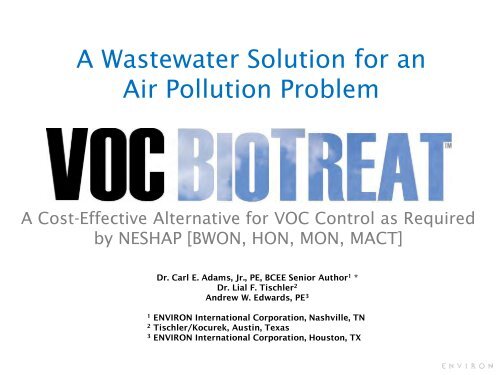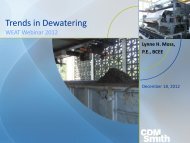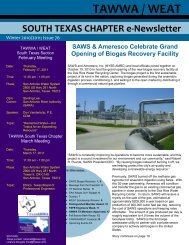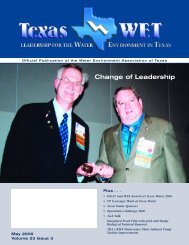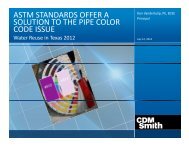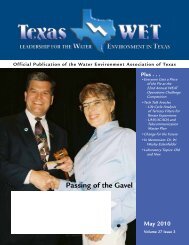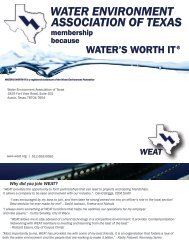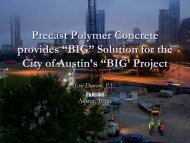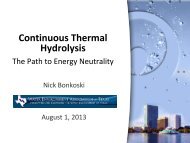A Wastewater Solution for an Air Pollution Problem
A Wastewater Solution for an Air Pollution Problem
A Wastewater Solution for an Air Pollution Problem
You also want an ePaper? Increase the reach of your titles
YUMPU automatically turns print PDFs into web optimized ePapers that Google loves.
A <strong>Wastewater</strong> <strong>Solution</strong> <strong>for</strong> <strong>an</strong><strong>Air</strong> <strong>Pollution</strong> <strong>Problem</strong>A Cost-Effective Alternative <strong>for</strong> VOC Control as Requiredby NESHAP [BWON, HON, MON, MACT]Dr. Carl E. Adams, Jr., PE, BCEE Senior Author 1 *Dr. Lial F. Tischler 2Andrew W. Edwards, PE 31ENVIRON International Corporation, Nashville, TN2Tischler/Kocurek, Austin, Texas3ENVIRON International Corporation, Houston, TX
BWON (Benzene Waste Operations NESHAP)• Aqueous <strong>Wastewater</strong> Considerations− Influent wastewater benzene concentration must be
BWON (Benzene Waste Operations NESHAP)<strong>Wastewater</strong> Gaseous Emissions Considerations• Title 40: Protection of Environment: 40 CFR § 61.340 presents threebasic Control Devices that are acceptable, pursu<strong>an</strong>t to specific designconstraints:(i) An enclosed combustion device (e.g., vapor incinerator, boiler, orprocess heater)(ii) A vapor recovery system (e.g., a carbon adsorption system or acondenser)(iii)A flare• Title 40: Protection of Environment: 40 CFR § 61.340 also states“other” Control Devices c<strong>an</strong> be used provided that certain conditionsare met.(iv) A control device other th<strong>an</strong> those described in paragraphs (a)(2) (i)through (iii) of this section may be used provided that the followingconditions are met:
BWON (Benzene Waste Operations NESHAP)<strong>Wastewater</strong> Gaseous Emissions Considerations(A) The device shall recover or control the org<strong>an</strong>ic emissions vented toit with <strong>an</strong> efficiency of 95 weight percent or greater, or shallrecover or control the benzene emissions vented to it with <strong>an</strong>efficiency of 98 weight percent or greater.(B) The owner or operator shall develop test data <strong>an</strong>d designin<strong>for</strong>mation that documents the control will achieve <strong>an</strong> emissioncontrol efficiency of either 95 percent or greater <strong>for</strong> org<strong>an</strong>iccompounds or 98 percent or greater <strong>for</strong> benzene.(C) The owner or operator shall identify:1) The critical operating parameters that affect the emissioncontrol per<strong>for</strong>m<strong>an</strong>ce of the device;2) The r<strong>an</strong>ge of values of these operating parameters that ensurethe emission control efficiency specified in paragraph(a)(2)(iv)(A) of this is maintained during operation of thedevice; <strong>an</strong>d3) How these operating parameter will be monitored to ensurethe proper operation <strong>an</strong>d mainten<strong>an</strong>ce of the device.
Overview•••••••••
Prestigious Accolade:National Gr<strong>an</strong>d Prize – Research Category 2011VOC BioTreat has garnered thecoveted National Gr<strong>an</strong>d Prize in theResearch category of theprestigious Americ<strong>an</strong> Academy ofEnvironmental Engineers (AAEE)2011 Excellence in EnvironmentalEngineering ® (E3) Competition.The concept was conceived,developed <strong>an</strong>d implemented by Dr.Carl E. Adams, Jr., Global PracticeArea Leader: Industrial <strong>Wastewater</strong>M<strong>an</strong>agement.
Kirkpatrick Award: SemifinalistKirkpatrick ChemicalEngineering AchievementAward recognizes the mostinnovative chemicalengineering technologyachieved through groupef<strong>for</strong>t <strong>an</strong>d successfullycommercialized worldwideduring the two years prior to<strong>an</strong> award year.Chemical EngineeringMagazine has awarded thisbiennial prize continuouslysince 1933.VOC BioTreat was the 2011Semi-Finalist
Louisi<strong>an</strong>a Section of the <strong>Air</strong> & Waste M<strong>an</strong>agementAssociation: 2011 Industry Award: Gr<strong>an</strong>d Prize
VOC BioTreat Technical Presentations <strong>an</strong>dPublications“A Cost-Effective Alternative <strong>for</strong> VOC Control as Required by NESHAP [BWON, HON, MON, MACT],” AIChE Workshop,Baton Rouge, LA, November 11, 2011.“Innovative Cost-Effective Control Device <strong>for</strong> <strong>Wastewater</strong> VOC Emissions (As Required by NESHAPs [BWON, HON, MON,MACT] <strong>an</strong>d Other Regulations),” ENVIRON, Houston, Texas, November 3, 2011.“Innovative Cost-Effective Control Device <strong>for</strong> <strong>Wastewater</strong> VOC Emissions (As Required by NESHAPs [BWON, HON, MON,MACT] <strong>an</strong>d Other Regulations),”WEFTEC 2011, October 17, Los Angeles, Cali<strong>for</strong>nia.“Innovative Cost-Effective Control Device <strong>for</strong> <strong>Wastewater</strong> VOC Emissions (As Required by NESHAPs [BWON, HON, MON,MACT] <strong>an</strong>d Other Regulations)”, CHEMINNOVATIONS Conference & Expo <strong>an</strong>d the collocated ISA Houston SectionConference & Expo., Houston, TX, George R. Brown Convention Center, Chemical Engineering Magazine, September13 - 15, 2011."A Cost Effective Alternative <strong>for</strong> VOC Control as Required by NESHAP [BWON, HON, MON, MACT, RACT <strong>an</strong>d OtherRegulations," <strong>Air</strong> & Waste M<strong>an</strong>agement Association's Annual Conference & Exhibition, Orl<strong>an</strong>do, FL on June 21-24,2011.“Biological Control of Benzene-Containing Off Gases”, Petroleum Environmental Research Forum, S<strong>an</strong> Ramon,Cali<strong>for</strong>nia, June 15, 2011.“Patented & Innovative Cost-Saving Control Device <strong>for</strong> Facility-Generated Volatile Org<strong>an</strong>ic Compound (VOC) Emissions”,Americ<strong>an</strong> Academy of Environmental Engineers, Excellence In Environmental Engineering, Conference AgendaNational Press Club, Washington, D.C., May 4, 2011.
VOC BioTreat Technical Presentations<strong>an</strong>d Publications (cont’d)“Innovative Cost-Effective Control Device <strong>for</strong> <strong>Wastewater</strong> VOC Emissions (As Required by NESHAPs [BWON, HON, MON,MACT] <strong>an</strong>d Other Regulations)”, Chemical Engineering Magazine VOC BioTreat Interview, April 15, 2011.Environmental News Record, interview <strong>for</strong> magazine with Gary Tulacz, April 1, 2011.“A Cost-Effective Alternative <strong>for</strong> VOC Control as Required by NESHAP [BWON, HON, MON, MACT]”, Annual Mid-Western<strong>Air</strong> & Waste M<strong>an</strong>agement Association's Annual Conference & Exhibition, K<strong>an</strong>sas City, December 2010.“Innovative Cost-Effective Control Device <strong>for</strong> <strong>Wastewater</strong> VOC Emissions (As Required by NESHAPs [BWON, HON, MON,MACT] <strong>an</strong>d Other Regulations)”, Annual 2010 National Petroleum Refiners Association Environmental Conference,S<strong>an</strong> Antonio, TX, September 20-21, 2010.“A Cost-Effective Alternative <strong>for</strong> VOC Control as Required by NESHAP [BWON, HON, MON, MACT]”, Annual Conference+Americ<strong>an</strong> Petroleum Institute’s Environmental Committee, Garyville, LA, June 2010.“A Cost-Effective Alternative <strong>for</strong> VOC Control as Required by NESHAP [BWON, HON, MON, MACT]”, AIChE Workshop,Chicago, IL, November 10, 2011.“ENVIRON VOC BioTreat, Un sistema innovativo per il controllo delle emissiona di VOC, Itali<strong>an</strong> Environmental EngineersAssociation (Aria y Aqua), Remtech, Ferrara, Itlay, Oct 2011. POSTER SESSION.“Treating Volatile Org<strong>an</strong>ics in Activated Sludge Treatment”, Indi<strong>an</strong> Environmental Association, Annual Conference“EnviroVision2011, Adv<strong>an</strong>ces in Environmental Technologies & M<strong>an</strong>agement, Ahmedabad, India, 24 th -26 th Nov,2011.
What is VOC BioTreat TM ?
What is VOC BioTreat?• VOC BioTreat is the process of qualifying <strong>an</strong> AlternativeControl Device, other th<strong>an</strong> Activated Carbon or ThermalOxidation, <strong>for</strong> the biodestruction of regulatedbiodegradable VOC emissions.• The Alternative Control Device is cost-effectively <strong>an</strong>existing activated sludge process with emission sources inproximity to a WWTP.
Typical Acceptable Control DevicesThermal Oxidizers:Flare or Gaseous IncineratorVapor-Phase Adsorption:Gr<strong>an</strong>ular Activated CarbonThermalOxidizersGr<strong>an</strong>ular ActivatedCarbon C<strong>an</strong>isters
Alternative Control Device
Alternative Control Device <strong>for</strong> a Refinery:A Basic OverviewCOMBINED WASTEWATER & AIR VOC BIOTREATMENT USING EXISTING FACILITIES<strong>Air</strong> VOC Emissions Piped to Existing Bio-BlowersSITE PROCESS/STORMWATERWASTEWATERSAPI SeparatorEQ T<strong>an</strong>kDissolvedNitrogenFlotationUnitAmbient<strong>Air</strong> InlettoBlowerActivatedSludgeBioreactorP-52SecondaryClarifierFINALEFFLUENTSite Process /Stormwater SumpAPI EntryWellAPIEffluentWellAPI PumpWellDNF WetWellAppropriateValving & LELInstrumentationRecycledBiomass
A Cost-Effective <strong>Solution</strong> <strong>for</strong> theBiodestruction of VOC Emissions• Incorporates ENVIRON-developed protocols todemonstrate <strong>an</strong> Alternative Control Device• Confirms the use of existing biologicalwastewater treatment facilities• Follows exact EPA requirements <strong>an</strong>d protocols<strong>for</strong> approval
A Cost-Effective <strong>Solution</strong> <strong>for</strong> theBiodestruction of VOC Emissions• Conclusively demonstrates co-treatment ofgaseous emissions or VOCs <strong>an</strong>d aqueoussoluble org<strong>an</strong>ics in existing wastewatertreatment facilities• Using these protocols, most activated sludgebiotreatment systems c<strong>an</strong> be qualified as <strong>an</strong>Alternative Control Device to treatbiodegradable VOCs• It is tr<strong>an</strong>sferable to other VOC/HAP <strong>an</strong>dother regulations• Provides excellent configuration flexibilitywith existing facilities
Regulatory Interface & Approval
Regulatory Approval
Regulatory Interface & ApprovalSpecific projectsState of Louisi<strong>an</strong>aState of Wyoming: in process of approvalState of Mississippi: in process of approvalRegular invitation to ENVIRONUSEPA Research Tri<strong>an</strong>gle Park: Presented as a Technical Seminars(2)USEPA region 5: Presented as a Technical SeminarUSEPA region 6: Presented as a Technical SeminarUSEPA region 7: Presented as a Technical SeminarUSEPA region 8: Presented as a Technical Seminar
Why VOC BioTreat TM ?
Why VOC BioTreat?• Economics, Economics, Economics!!!Typical systems (carbon or TOs) have much higheroperating costs• O&M costs are typically
VOC BioTreat ApplicationIndustrial Sectors• Refineries: BWON• Org<strong>an</strong>ic Chemicals: MACT (e.g., HON, MON, etc)• Pharmaceuticals: Pharma MACT• Coke pl<strong>an</strong>ts (steel industry): BWON• Soil-Vapor-Extraction remediation systemsRegulatory Drivers• Alternative NESHAP <strong>Wastewater</strong> Emission Control• WWTP Compli<strong>an</strong>ce Assur<strong>an</strong>ce Monitoring Optimization(CAM) <strong>for</strong> biological destruction efficiency (F bio )• Process Vent Control
VOC BioTreat Typical ApplicationsSoil-Vapor-Extraction
VOC BioTreat Projects in 2011Client Location Industrial Classification3M Corporation Cordova, IL Org<strong>an</strong>ic ChemicalsAdvocacy Project w/PERF Oakl<strong>an</strong>d, CA Refinery<strong>Air</strong> Products & Chemicals Calvert City, KY Org<strong>an</strong>ic ChemcialsCel<strong>an</strong>ese Corporation Meredosia, IL Org<strong>an</strong>ic ChemicalsChevron Refining Pascagoula, MS RefineryConocoPhillips-Alli<strong>an</strong>ce Belle Chasse, LA RefineryDuPont Corporation Kinston, NC Org<strong>an</strong>ic chemicalsExxonMobil Refining Baton Rouge, LA RefineryFrontier Refining Cheyenne, WO RefineryHEXION Louisville, KY Org<strong>an</strong>ic ChemicalsMarathon Petroleum Robinson, IL RefineryMarathon Petroleum Texas City, TX RefineryMarathon Petroleum Detroit, MI RefineryMarathon Petroleum Garyville, LA RefineryNOVACHEM Red Deer, C<strong>an</strong>ada Ethylene RefinerySABIC Ottawa, IL Org<strong>an</strong>ic ChemicalsShell Chemical Co. Deer Park, TX Org<strong>an</strong>ic ChemicalsShell Oil Co. Australia RefineryTEVA Mexico, MO PharmaceuticalsUS Steel Gary, IN Coking FacilityValero Refining Houston, TX RefineryValero Refining Pt. Arthur, TX RefineryValero Refining Corpus Christi, TX Refinery
ConclusionsVOC BioTreat TM – the ProcessHow is it Applicable?
High-Level Assessment:Comprehensive Questionnaire• Existing WWTP amenable to the technology?Diffused aeration systemDeep t<strong>an</strong>ksExisting blowers have adequate air flow treatment capacity(modification may be necessary)• VOC emission sources appropriate <strong>for</strong> technology?Compounds relatively biodegradableCompounds have sufficient solubility(relatively low Henry s Law const<strong>an</strong>ts)VOC air volume compatible with WWTP diffused air treatment capacity• Favorable economics?Reasonable proximity of VOC sources to WWTPCurrent system O&M costsMinimal modifications required to adapt WWTP to technology
VOC BioTreat – The ProcessSTEP 1STEP 2STEP 3STEP 4STEP 5STEP 6High-Level Feasibility EvaluationDevelop preliminary facility-specific model with assumedbiodegradation rate to gauge benzene removal per<strong>for</strong>m<strong>an</strong>cerequirements <strong>an</strong>d obtain initial Agency concurrence <strong>for</strong> approachConduct BOX testing to determine site-specific VOCbiodegradation rate <strong>an</strong>d maximize VOC BioTreat effectivenessConduct Core Column Simulation Full-scale confirmation testingObtain final Agency approval of Alternative Control DevicePrepare detailed engineering pl<strong>an</strong> <strong>an</strong>d implement AlternativeControl Device solutionSteps 1 & 2 must be concluded favorably be<strong>for</strong>e proceeding withthe remaining steps.
Case HistoryMarathon Petroleum Comp<strong>an</strong>yGaryville Refinery (MPC)Garyville, Louisi<strong>an</strong>aPetroleum Refinery: BWON Alternative Control Device
Why was MPC-Garyville <strong>an</strong> Excellent Choice?• Economics, Economics, Economics!− Current MPC system had very high operating cost (energy <strong>an</strong>dcarbon)− Discarding initial capital investment wasn’t a deal breaker− BioTreat alternative costs almost nothing to operate• OK, it wasn’t all economics!− N2 bl<strong>an</strong>ket system leakage degrading overall per<strong>for</strong>m<strong>an</strong>ce ofcurrent system (not <strong>an</strong> issue <strong>for</strong> BioTreat alternative)− Reduction in carbon footprint, better sustainability aspects− Subst<strong>an</strong>tial reduction in energy requirements− Simplicity of installation <strong>an</strong>d operation of BioTreat alternative(mainten<strong>an</strong>ce cost likely much lower)
Current/Proposed Benzene Control DevicesMPC asked ENVIRONto develop protocolsto qualify theexisting activatedsludge system (AIS)as <strong>an</strong> AlternativeControl Device.
MPC Case History – EconomicEconomic Impacts <strong>for</strong> VOC Control DevicesMPC – Garyville Refinery WWTPPROCESS TECHNOLOGYCOST-EFFECTIVE IMPACTCapitalcost ($)Annualoperating cost ($)Thermal Oxidizer 600,000 340,000Gr<strong>an</strong>ular Activated Carbon(6 carbon c<strong>an</strong>isters on each of two APIseparators, 22 ch<strong>an</strong>ge-outs/yr per API)+ Mainten<strong>an</strong>ce of N 2 bl<strong>an</strong>ketBiological(piping, f<strong>an</strong>s <strong>an</strong>d connection to blowers)240,000 500,000600,000 Minimal
MPC Case History – SustainabilityEconomic Impacts <strong>for</strong> VOC Control DevicesMPC – Garyville Refinery WWTPProcess TechnologyThermal Oxidizer(calculated)Gr<strong>an</strong>ular Activated Carbon(in operation)ANNUAL IMPACTEnergy ConsumptionMillion BTUs per yearCO 2 EmissionsTons CO 2 per year45,700 2,690192 10Biological(no additional energy required orCO 2 generated, due to minimalorg<strong>an</strong>ics being treated)MinimalMinimal
Proposed Alternative Control DeviceBioReactor ConstructionUNICELLInduced <strong>Air</strong>Flotation(IGF)Marathon Petroleum Comp<strong>an</strong>yGaryville, Louisi<strong>an</strong>a RefineryClosed-CircuitCooling Tower
Reliable Data on BenzeneCritical Benzene Mass Bal<strong>an</strong>ce <strong>for</strong> MPC–Garyville
Inputs to Site-Specific ModelMajor Variables• Benzene Biodegradation Rate− Table 2 represents variousexperimentally-determined bioratesfrom API <strong>an</strong>d ENVIRON databases• <strong>Air</strong> Flow• Biomass Concentrations• Potential Benzene InjectionLocations into AIS• Benzene Loadings & Mass Bal<strong>an</strong>ceOther Signific<strong>an</strong>t Variables• <strong>Air</strong> Distribution in Zones• Depth of BioReactor• Aeration T<strong>an</strong>k Surface Area• Temperature• Hydraulic Flow Rate & CODLoading
Models <strong>for</strong> Calculating VOC BioTreat Emissions•−−−•• “ ”•−•−−
BWON Modeling Benzene Biodegradation RatesBENZENE BIODEGRADATION RATES – EXPERIMENTAL VALUESData referred to as APIis from Table 5 of theAPI/NPRA comments toEPA datedDecember 28, 2007.Refinery Test Type Date RunsK1 (L/g VSS-hr) @ 20 o CAverage <strong>for</strong>Multiple RunsValue Selected<strong>for</strong> ModelEvaluationAPI-A BOX Nov-06 2 48.9 -----API-AMethod304ANov-06 1 120.1 84.5API -B BOX Oct-97 1 79.1 79.1API-C BOX Oct-97 2 78.4 78.4API-D EKR Jul-96 4 17.3 17.3API-D BOX Jul-96 5 122 -----API-E BOX Sept-94 5 122 -----API-E BOX Nov-94 2 31 -----API-E BOX Dec-94 6 199 -----API-E BOX Apr-95 5 199 -----API-E BOX Apr-95 7 172API-E BOX Jun-95 4 206 185.5API-F BOX Jul-95 3 4.4 4.4API-G Mar-00 3 64 64ENVIRON-1 BOX Jul-09 2 23.4 23.4ENVIRON-2 BOX Mar-11 1 19.7 19.7ENVIRON-3 BOX Aug-11 1 10.8 10.8ENVIRON-4 BOX Aug-11 1 6.4 6.4API Water 9 Default Rate (EPA requires that Default Rate be used if industrychooses not to conduct BOX Test to determine site-specific benzenebiodegradation rate.1.4
Benzene Removal with Preliminarily AssumedRates vs. Actual Site-Specific Rate(Corrected to 20°C)
Develop Site-Specific Biodegradation Rate;Select Appropriate EPA-Recommended ApproachSource: EPA 40 CFR part 63, Appendix C, Figure 1
Develop Site-Specific Biodegradation RateBOX Test Apparatus that is typically usedTypical BOX Test ApparatusOption 1Typical BOX Test ApparatusOption 2
Develop Site-Specific Biodegradation RateBOX Test Apparatus Developed by ENVIRON
Develop Site-Specific Biodegradation RateBOX Test Column(without aeration)<strong>Air</strong> Supply T<strong>an</strong>k(Supplies BOX TestColumn & GC)Fine-Bubble <strong>Air</strong>Diffuser (Off)
Develop Site-Specific Biodegradation RateVoyager Photovac OnlinePhoto-ionization GCSample Syringes
Comparative Results of BenzeneStripping with <strong>an</strong>d without BiomassBENZENE IN OFF-GAS EMISSIONS (ppmv)25020015010050WITHOUT BIOMASS~2 mg/L Benzene added to filtered effluentWITH BIOMASS~2 mg/L Benzene added to biomassMLVSS concentration of 800 mg/L00 50 100 150 200 250 300 350 400 450TIME (min)
Development of Preliminary Site-SpecificBenzene Control ModelRerun Calibrated Model with Site-SpecificBiodegradation Rate• The site-specific biodegradation rate, corrected to 20°C, is22.6 L/g VSS-hr @ 20°C at Marathon-Garyville• The Toxchem+ model will adjust the rate to the selectedtemperature <strong>for</strong> full-scale operating conditions
Benzene Removal with Preliminarily AssumedRates vs. Actual Site-Specific Rate(corrected to 20°C)
Full-Scale Confirmation Flux Chamber:Less Desirable Option
Full-Scale ConfirmationPer<strong>for</strong>m<strong>an</strong>ce Validation ofFull-Scale SystemUsing VOC BioTreatColumn Protocols
Full-Scale Confirmation
Off-gas ventSample gas lineto on-line gcGravity overflow line backto full-scale aerobic zoneFull-Scale ConfirmationPer<strong>for</strong>m<strong>an</strong>ceValidation ofFull-Scale SystemUsing VOC BioTreatColumn ProtocolsRecycle biomassPortInfluent<strong>Wastewater</strong>Sample portSupportpipe(empty)Aeration +Benzene inputDrain
Full-Scale Confirmation
Full-Scale Confirmation ResultsBenzene <strong>an</strong>alytical results of full-scale confirmationRun #Benzene ConcentrationppbvOutletBlower InletVentBenzeneBiodestruction(%)Percent ofDesignCondition1 21 < 2.0 > 90.6 100%Per<strong>for</strong>m<strong>an</strong>ceVersus RegulatoryRequirementsInconclusive due to<strong>an</strong>alytical limitations3A 121 < 2.0 > 98.3 >500% Exceeds3B 153 < 2.0 > 98.7 >700% Exceeds4A 156 < 2.0 > 98.7 >700% Exceeds4B 482 13.3 > 97.2 >2200% Below5A 182 < 2.0 > 98.9 >800% Exceeds5B 226 < 2.0 > 99.1 >1000% ExceedsDesign is 98% at inlet of 14 ppb. Results showed 16 times thatcapacity. Breakthrough at ~400-500 ppbv.
Regulatory ApprovalRepeat ofSlide 15
Case HistoryEconomic Evaluations <strong>for</strong> SustainabilityConfirmation
Western Refinery, Wyoming, USA: 65,000 bbls/day
Case History – EconomicEconomic Impacts <strong>for</strong> VOC Control DevicesProcess TechnologyCapital cost($)Cost-Effective ImpactAnnual OperatingCost ($)Gr<strong>an</strong>ular Activated Carbon (2 large carbonvessels on DAFs, multiple other carbonc<strong>an</strong>isters; over 300,000 lbs/yr activatedcarbon consumption w/ no reactivationoption)VOC BioTreat (validation, engineeringpiping, instrumentation, <strong>an</strong>d connectionto blowers)200,000 780,000460,000 < 10,000
Energy Savings / Sustainability AspectsCase Study No. 2: Replace Activated Carbon C<strong>an</strong>isters at Wyoming RefinerySustainability AspectsCase StudyScenarioBenzene Control TechnologyEnergy Consumption ActivityTotal Energy Usage(mmBTU/year)Carbon Emissions(tons CO2/year)Activated Carbon C<strong>an</strong>istersCurrentControlSystemTr<strong>an</strong>sport to/from Reactivation Facility 547 63Reactivation Process (315,000 lbs/yr) 1,859 116Totals 2,406 179VOC BioTreatAlternativeBiological Treatment in WWTPAdditional Power <strong>for</strong> Aeration Blowers 8.1 2.5Total Energy Savings / GHG reductions 2,398 177
Current Benzene Vapor Controls: SE, USA Refinery(Activated Carbon C<strong>an</strong>isters), 350,000 bbls/dayBOTTOMSMainSumpAPI#7FLOAT3 DNF UnitsCPI #6= 2,000 lb C<strong>an</strong>ister= 1,000 lb C<strong>an</strong>ister= 20,000 lb ContainerAPI #2API#1
SavingsCase Study No. 3: Replace Activated Carbon C<strong>an</strong>isters at Mississippi RefinerySustainability AspectsCase StudyScenarioBenzene Control TechnologyEnergy Consumption ActivityTotal Energy Usage(mmBTU/year)Carbon Emissions(tons CO2/year)Activated Carbon C<strong>an</strong>istersCurrentControlSystemTr<strong>an</strong>sport to/from Reactivation Facility 422 146Reactivation Process 1,564 98Totals 1,985 244VOC BioTreatAlternativeBiological Treatment in WWTPAdditional Power <strong>for</strong> Aeration Blowers 10.8 1.0Total Energy Savings / GHG reductions 1,974 243
Redirect Vent Stream from Flare to BiologicalWWTP, MidWest, USA, Refinery, 200,000 bbls/day
Case Study No. 4: Replace Small Dedicated Flare at Illinois RefinerySustainability AspectsCase StudyScenarioBenzene Control TechnologyEnergy Consumption ActivityTotal Energy Usage(mmBTU/year)Carbon Emissions(tons CO2/year)Steam-Assisted FlareCurrentControlSystemNat. Gas Pilot <strong>an</strong>d Refinery Fuel Gas 48,640 2,860Steam Assist <strong>an</strong>d Blower 10,648 632Totals 59,288 3,492VOC BioTreatAlternativeBiological Treatment in WWTPAdditional Power <strong>for</strong> Aeration Blowers 13.0 4.0Total Energy Savings / GHG reductions 59,275 3,488
Schematic of <strong>Wastewater</strong> Treatment Pl<strong>an</strong>t withCurrent Benzene Vapor Controls (8,000 scfm RTO)RTO
Case Study No. 5: Replace regenerative Thermal Oxidizer at Texas RefinerySustainability AspectsCase StudyScenarioBenzene Control TechnologyEnergy Consumption ActivityTotal Energy Usage(mmBTU/year)Carbon Emissions(tons CO2/year)Regenerative Thermal OxidizerCurrentControlSystemSupplemental Fuel (nat. gas) 12,960 765Electric Power <strong>for</strong> RTO Blower 260 80Totals 13,219 845VOC BioTreatAlternativeBiological Treatment in WWTPAdditional Power <strong>for</strong> Aeration Blowers 15.2 4.7Total Energy Savings / GHG reductions 13,204 840
Questions & Answers


